Etiqueta "Programción funcional"
Se han encontrado 20 Coincidencias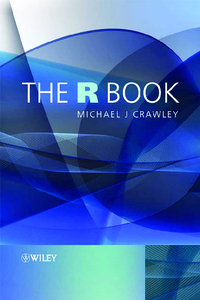
The R Book
Estadística computacional
207 Visitas | 249 Descargas | 2013-10-01 03:27:09 | rmartinez
The high-level language of R is recognized as one of the most powerful and flexible statistical software environments, and is rapidly becoming the standard setting for quantitative analysis, statistics and graphics. R provides free access to unrivalled coverage and cutting-edge applications, enabling the user to apply numerous statistical methods ranging from simple regression to time series or multivariate analysis. Building on the success of the author’s bestselling Statistics: An Introduction using R, The R Book is packed with worked examples, providing an all inclusive guide to R, ideal for novice and more accomplished users alike. The book assumes no background in statistics or computing and introduces the advantages of the R environment, detailing its applications in a wide range of disciplines. Provides the first comprehensive reference manual for the R language, including practical guidance and full coverage of the graphics facilities. Introduces all the statistical models covered by R, beginning with simple classical tests such as chi-square and t-test. Proceeds to examine more advance methods, from regression and analysis of variance, through to generalized linear models, generalized mixed models, time series, spatial statistics, multivariate statistics and much more. The R Book is aimed at undergraduates, postgraduates and professionals in science, engineering and medicine. It is also ideal for students and professionals in statistics, economics, geography and the social sciences.
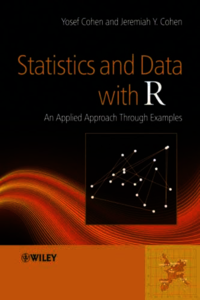
Statistics and Data with R. An applied approach through examples
147 Visitas | 202 Descargas | 2013-10-29 21:40:59 | rmartinez
The book is intended for students, researchers and practitioners both in and out of academia. However, no prior knowledge of statistics is assumed. Consequently, the presentation moves from very basic (but not simple) to sophisticated. Even if you know statistics and R, you may find the many many examples with a variety of real world data, graphics and analyses useful. You may use the book as a reference and, to that end, we include two extensive indices. The book includes (almost) parallel discussions of analyses with the normal density, proportions (binomial), counts (Poisson) and bootstrap methods.
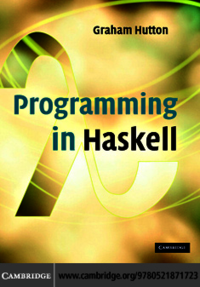
Programming in Haskell
Programación en Haskell
84 Visitas | 84 Descargas | 2014-03-03 15:25:13 | alvarojs
Haskell is one of the leading languages for teaching functional programming, enabling students to write simpler and cleaner code, and to learn how to structure and reason about programs. This introduction is ideal for beginners: it requires no previous programming experience and all concepts are explained from first principles with the aid of carefully chosen examples. Each chapter includes a series of exercises, ranging from the straightforward to extended projects, along with suggestions for further reading on more advanced topics. The presentation is clear and simple, and benefits from having been refined and class-tested over several years.

Yet Another Haskell Tutorial
Programacion en Haskell
55 Visitas | 63 Descargas | 2014-03-03 15:30:52 | alvarojs
The goal of the Yet Another Haskell Tutorial is to provide a complete intoduction to the Haskell programming language. It assumes no knowledge of the Haskell language or familiarity with functional programming in general. However, general familiarity with programming concepts (such as algorithms) will be helpful. This is not intended to be an introduction to programming in general; rather, to programming in Haskell. Sufficient familiarity with your operating system and a text editor is also necessary (this report only discusses installation on configuration on Windows and *Nix system; other operating systems may be supported – consult the documentation of your chosen compiler for more information on installing on other platforms).

The Haskell Road to Logic, Math and Programming
Programación en Haskell
65 Visitas | 75 Descargas | 2014-03-05 17:15:27 | alvarojs
The subject of this book is the use of logic in practice, more in particular the use of logic in reasoning about programming tasks. Logic is not taught here as a mathematical discipline per se, but as an aid in the understanding and construction of proofs, and as a tool for reasoning about formal objects like numbers, lists, trees, formulas, and so on. As we go along, we will introduce the concepts and tools that form the set-theoretic basis of mathematics, and demonstrate the role of these concepts and tools in implementations. These implementations can be thought of as representations of the mathematical concepts.
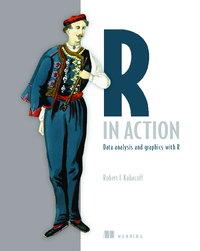
R in Action
Programación en R
100 Visitas | 105 Descargas | 2015-04-30 14:50:46 | josedanielr
R in Action provides you with a guided introduction to R, giving you a 2,000-foot view of the platform and its capabilities. It will introduce you to the most important functions in the base installation and more than 90 of the most useful contributed packages. Throughout the book, the goal is practical application—how you can make sense of your data and communicate that understanding to others. When you finish, you should have a good grasp of how R works and what it can do, and where you can go to learn more. You’ll be able to apply a variety of techniques for visualizing data, and you’ll have the skills to tackle both basic and advanced data analytic problems.
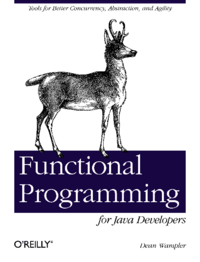
Functional Programming for Java Developers
Functional Programming for Java Developers
112 Visitas | 147 Descargas | 2015-11-02 15:24:52 | pecarrazana
Welcome to Functional Programming for Java Developers Why should a Java developer learn about functional programming (FP)? After all, hasn’t functional programming been safely hidden in academia for decades? Isn’t object-oriented programming (OOP) all we really need? This book explains why functional programming has become an important tool for the challenges of our time and how you, a Java developer, can use it to your advantage. The recent interest in functional programming started as a response to the growing pervasiveness of concurrency as a way of scaling horizontally, through parallelism. Multithreaded programming (see, e.g., [Goetz2006]) is difficult to do well and few developers are good at it. As we’ll see, functional programming offers better strategies for writing robust, concurrent software. An example of the greater need for horizontal scalability is the growth of massive data sets requiring management and analysis, the so-called big data trend. These are data sets that are too large for traditional database management systems. They require clusters of computers to store and process the data. Today, it’s not just Google, Yahoo!, Facebook, and Twitter who work with big data. Many organizations face this challenge. Once you learn the benefits of functional programming, you find that it improves all the code you write. When I learned functional programming a few years ago, it re-energized my enthusiasm for programming. I saw new, exciting ways to approach old problems. The rigor of functional programming complemented the design and testing benefits of test-driven development, giving me greater confidence in my work. I learned functional programming using the Scala programming language [Scala] and co-wrote a book on Scala with Alex Payne, called Programming Scala (O’Reilly). Scala is a JVM language, a potential successor to Java, with the goal of bringing object-oriented and functional programming into one coherent whole. Clojure is the other well-known functional language on the JVM. It is a Lisp dialect that minimizes the use of OOP in favor of functional programming. Clojure embodies a powerful vision for how pro- gramming should be done.
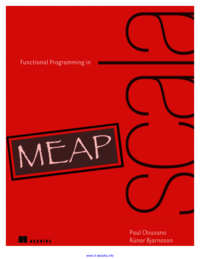
Functional Programming in Scala
Functional Programming in Scala MEAP
68 Visitas | 98 Descargas | 2015-11-02 15:34:17 | pecarrazana
This book introduces the concepts and techniques of functional programming (FP)—we use Scala as the vehicle, but the lessons here in can be applied to programming in any language. Our goal is to give you the foundations to begin writing substantive functional programs and to comfortably absorb new FP concepts and techniques beyond those covered here. Throughout the book we rely heavily on programming exercises, carefully chosen and sequenced to guide you to discover FP for yourself. Expository text is often just enough to lead you to the next exercise. Do these exercises and you will learn the material. Read without doing and you will find yourself lost.
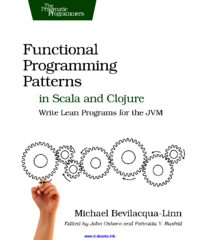
Functional Programming Patterns in Scala and Clojure
Functional Programming Patterns in Scala and Clojure
70 Visitas | 80 Descargas | 2015-11-02 15:38:56 | pecarrazana
This book is about patterns and functional programming in Scala and Clojure. It shows how to replace, or greatly simplify, many of the common patterns we use in object-oriented programming, and it introduces some patterns commonly used in the functional world. Used together, these patterns let programmers solve problems faster and in a more concise, declarative style than with object-oriented programming alone. If you’re using Java and want to see how functional programming can help you work more efficiently, or if you’ve started using Scala and Clojure and can’t quite wrap your head around functional problem-solving, this is the book for you.
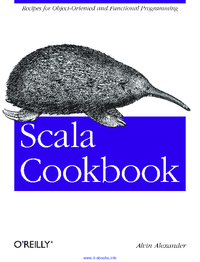
Scala Cookbook
Scala Cookbook
130 Visitas | 84 Descargas | 2015-11-02 15:41:21 | pecarrazana
This is a cookbook of problem-solving recipes about Scala, the most interesting programming language I’ve ever used. The book contains solutions to more than 250 common problems, shown with possibly more than 700 examples. (I haven’t counted, but I suspect that’s true.) There are a few unique things about this book: • As a cookbook, it’s intended to save you time by providing solutions to the most common problems you’ll encounter. • Almost all of the examples are shown in the Scala interpreter. As a result, whether you’re sitting by a computer, on a plane, or reading in your favorite recliner, you get the benefit of seeing their exact output. (Which often leads to, “Ah, so that’s howthat works.”) • The book covers not only the Scala language, but also has large chapters on Scalatools and libraries, including SBT, actors, the collections library (more than 100pages), and JSON processing. Just prior to its release, the book was updated to cover Scala 2.10.x and SBT 0.12.3.
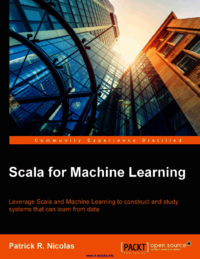
Scala for Machine Learning
Scala for Machine Learning
83 Visitas | 95 Descargas | 2015-11-02 15:43:18 | pecarrazana
Not a single day passes by that we do not hear about Big Data in the news media, technical conferences, and even coffee shops. The ever-increasing amount of data collected in process monitoring, research, or simple human behavior becomes valuable only if you extract knowledge from it. Machine learning is the essential tool to mine data for gold (knowledge). This book covers the "what", "why", and "how" of machine learning: • What are the objectives and the mathematical foundation of machine learning? • Why is Scala the ideal programming language to implement machine learning algorithms? • How can you apply machine learning to solve real-world problems? Throughout this book, machine learning algorithms are described with diagrams, mathematical formulation, and documented snippets of Scala code, allowing you to understand these key concepts in your own unique way.
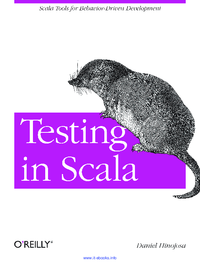
Testing in Scala
67 Visitas | 86 Descargas | 2015-11-02 15:47:56 | pecarrazana
This book enhances the Scala language with standard test-driven development practices, highlighting the best testing tools today. This book will cover both the ScalaTest and the Specs2 testing frameworks, which help you create quick and easy tests. Testing is also often the most overlooked aspect of introductory programming language books. This book is dedicated to mending that gap.We will run all these tests using Simple Build Tool (SBT). SBT is similar to some earlier build tools and competitors: Maven, Gradle, and Buildr. What makes SBT highly attractive is its ease of use and the small size of the build file. Type a few lines of code for your build file and you’re off and running on your project. We will also cover SBT’s wonderful triggered execution feature, which complements test-driven development by building and testing code whenever a file is saved.ScalaTest and Specs2 are two of the most dominant testing frameworks for Scala around today. Each framework has a different intent and goal, but they share the some ideal of making testing concise, and they both leverage the Scala programming language to make testing easy and fun. Testing frameworks are nothing new, of course, and have been used with other programming languages for years. Those familiar with other programming languages and their testing tools will find some similarities with Scala’s current testing tools. ScalaTest and Specs2 borrowed ideas from Cucumber. But upon these shoulders of giants, Scala testing systems have also stepped out on their own and created some of the most mind-blowing testing tools found in any language. Testing in Scala will also illustrate mocking code, so as to keep our tests isolated from large subsystems and networks. Mocking is, in essence, creating a substitute for various objects to isolate tests from volatile elements of their environment (such as the contents of databases) and to help unit tests run fast. This book shows how you can use Scala with Java-based mocking frameworks that have been used for years by Java programmers, EasyMock and Mockito. We will also introduce you to a new framework, ScalaMock. Formerly known as Borachio, ScalaMock was inspired by Java’s EasyMock and Mockito but takes their work further, even offering support for mocking final classes and Scala objects.
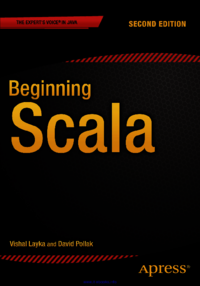
Beginning Scala, 2nd Edition
Programación en Scala
73 Visitas | 95 Descargas | 2016-01-05 19:44:46 | asielalonso
The first step in writing Scala is not being afraid of the fact that Scala’s going to warp your brain. The next step in writing Scala is accepting that your code is going to look like Java, Ruby, Python, whatever code for a while. It will take you time and effort and more time to code Scala using the idioms in this book. It will take you time to design code that fits into Scala paradigms and to discover and devise paradigms of your own. It will take time but hopefully less time than it took me. This book is for you. It’s my attempt to show you a different way of thinking about and writing code. I hope that you’ll enjoy our journey through Scala together. I hope that by the end of this book you’ll have a new perspective on coding. I hope that you’ll be writing better code and fewer lines of code yet are happier about the code that you’re writing. So, come along. Stick that little toe in the Scala waters and see if they feel as good for you as they have for me.
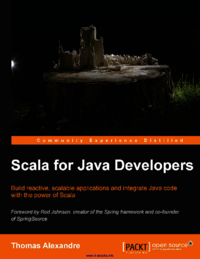
Scala for Java Developers
Programación en Scala
76 Visitas | 106 Descargas | 2016-01-05 19:49:08 | asielalonso
As a Java developer, you must have heard a lot about Scala, even if you haven't yet written any Scala code. You must have noticed that Scala is becoming popular and heard vigorous debate about it. As I sat down to write this, I typed "scala is" into Google. The top completions included "scala is awesome", "scala is too complex", and "scala is hard." Understandably, you may be confused by such polarization. You may also have heard arcane, possibly off-putting details about obscure Scala idioms and advanced functional programming. What you probably have not heard is a methodical, impartial attempt to answer questions such as "might Scala make me more productive in my daily work?", "will it be easy for me to pick up Scala?", and ultimately, "Should I switch from Java to Scala?".
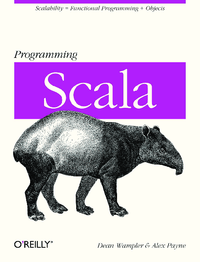
Programming Scala
Programación en Scala
66 Visitas | 89 Descargas | 2016-01-05 19:52:05 | asielalonso
When I discovered Scala some years ago, the thing that made the biggest impression on me was its composability. Through some very elegant design choices and simple yet powerful abstractions that were taken from the object-oriented and functional programming worlds, Martin Odersky has managed to create a language with high cohesion and orthogonal, deep abstractions that invites composability in all dimensions of software design. Scala is truly a SCAlable LAnguage that scales with usage, from scripting all the way up to large-scale enterprise applications and middleware. Scala was born out of academia, but it has grown into a pragmatic and practical language that is very much ready for real-world production use. You are about to learn how to write reusable components using mixin and function composition; how to write concurrent applications using Scala’s Actors; how to make effective use of Scala’s XML/XPath support; how to utilize Scala?s rich, flexible, and expressive syntax to build Domain-Specific Languages; how to effectively test your Scala code; how to use Scala with popular frameworks such as Spring, Hadoop, and Terracotta; and much, much more. Enjoy the ride. I sure did.
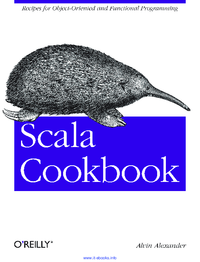
Scala Cookbook
Programación en Scala
81 Visitas | 116 Descargas | 2016-01-05 19:55:56 | asielalonso
Save time and trouble when using Scala to build object-oriented, functional, and concurrent applications. With more than 250 ready-to-use recipes and 700 code examples, this comprehensive cookbook covers the most common problems you'll encounter when using the Scala language, libraries, and tools. It's ideal not only for experienced Scala developers, but also for programmers learning to use this JVM language.
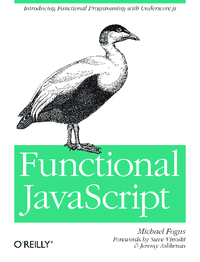
Introducing Functional Programming with Underscore.js
Introducing Functional Programming with Underscore.js
79 Visitas | 85 Descargas | 2016-02-24 15:19:38 | pecarrazana
Underscore.js (hereafter called Underscore) is a JavaScript library supporting functional programming. The Underscore website describes the library as such: Underscore is a utility-belt library for JavaScript that provides a lot of the functional programming support that you would expect in Prototype.js (or Ruby), but without ex? tending any of the built-in JavaScript objects. In case you didn’t grow up watching the kitschy old Batman television show, the term “utility belt” means that it provides a set of useful tools that will help you solve many common problems.
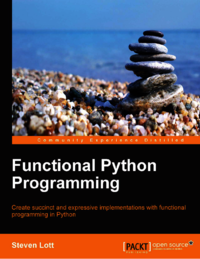
Functional Python Programming
103 Visitas | 109 Descargas | 2016-04-05 15:26:52 | efirvida
Programming languages sometimes fit neatly into tidy categories like imperative and functional. Imperative languages might further subdivide into those that are procedural and those that include features for object-oriented programming. The Python language, however, contains aspects of all of these three language categories. Though Python is not a purely functional programming language, we can do a great deal of functional programming in Python.
Contribuir
Usted puede contribuir con Libros UCLV, es importante para nosotros su aporte..
Contribuir